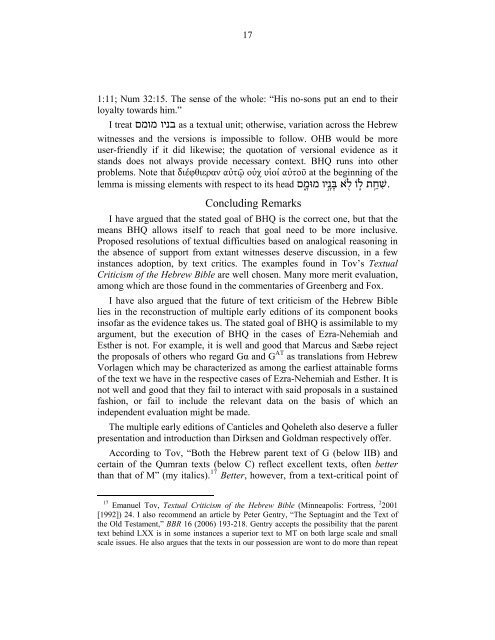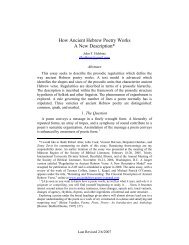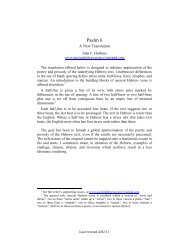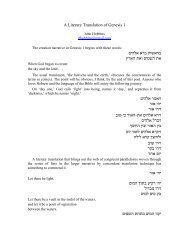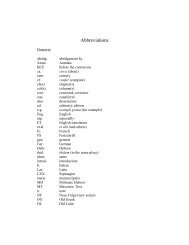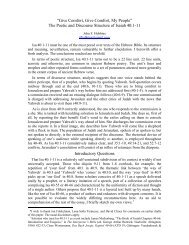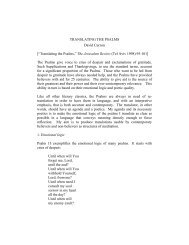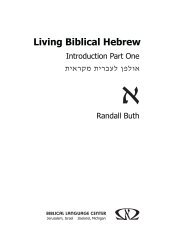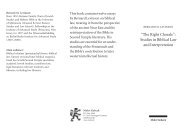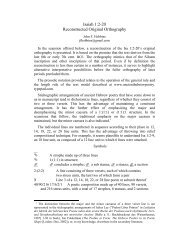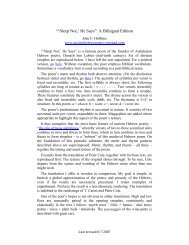Whither Biblia Hebraica Quinta - Ancient Hebrew Poetry
Whither Biblia Hebraica Quinta - Ancient Hebrew Poetry
Whither Biblia Hebraica Quinta - Ancient Hebrew Poetry
- No tags were found...
You also want an ePaper? Increase the reach of your titles
YUMPU automatically turns print PDFs into web optimized ePapers that Google loves.
171:11; Num 32:15. The sense of the whole: “His no-sons put an end to theirloyalty towards him.”I treat בניו מומם as a textual unit; otherwise, variation across the <strong>Hebrew</strong>witnesses and the versions is impossible to follow. OHB would be moreuser-friendly if it did likewise; the quotation of versional evidence as itstands does not always provide necessary context. BHQ runs into otherproblems. Note that διέφθιεραν αὐτῷ οὐχ υἱοί αὐτοῦ at the beginning of the.שִׁ חֵ ֥ ת ל֛ וֹ ֖ ל ֹא בָּ נָ ֣יו מוּמָ ֑ ם lemma is missing elements with respect to its headConcluding RemarksI have argued that the stated goal of BHQ is the correct one, but that themeans BHQ allows itself to reach that goal need to be more inclusive.Proposed resolutions of textual difficulties based on analogical reasoning inthe absence of support from extant witnesses deserve discussion, in a fewinstances adoption, by text critics. The examples found in Tov’s TextualCriticism of the <strong>Hebrew</strong> Bible are well chosen. Many more merit evaluation,among which are those found in the commentaries of Greenberg and Fox.I have also argued that the future of text criticism of the <strong>Hebrew</strong> Biblelies in the reconstruction of multiple early editions of its component booksinsofar as the evidence takes us. The stated goal of BHQ is assimilable to myargument, but the execution of BHQ in the cases of Ezra-Nehemiah andEsther is not. For example, it is well and good that Marcus and Sæbø rejectthe proposals of others who regard Gα and G AT as translations from <strong>Hebrew</strong>Vorlagen which may be characterized as among the earliest attainable formsof the text we have in the respective cases of Ezra-Nehemiah and Esther. It isnot well and good that they fail to interact with said proposals in a sustainedfashion, or fail to include the relevant data on the basis of which anindependent evaluation might be made.The multiple early editions of Canticles and Qoheleth also deserve a fullerpresentation and introduction than Dirksen and Goldman respectively offer.According to Tov, “Both the <strong>Hebrew</strong> parent text of G (below IIB) andcertain of the Qumran texts (below C) reflect excellent texts, often betterthan that of M” (my italics). 17 Better, however, from a text-critical point of17 Emanuel Tov, Textual Criticism of the <strong>Hebrew</strong> Bible (Minneapolis: Fortress, 2 2001[1992]) 24. I also recommend an article by Peter Gentry, “The Septuagint and the Text ofthe Old Testament,” BBR 16 (2006) 193-218. Gentry accepts the possibility that the parenttext behind LXX is in some instances a superior text to MT on both large scale and smallscale issues. He also argues that the texts in our possession are wont to do more than repeat


